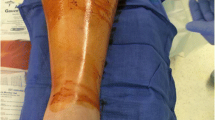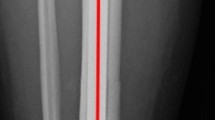Abstract
Intramedullary nailing of tibial fractures is commonplace, and freehand operative techniques are increasingly popular. The standard freehand method has the knee of the injured leg flexed over a radiolucent bolster. This requires the theatre fluoroscope to swing from antero-posterior to lateral position several times. Furthermore, guide wire placement, reaming and nail insertion are all performed well above most surgeons’ shoulder height. Alternatively the leg is hung over the edge of the table, and the assistant must crouch and hold the leg until the nail is passed beyond the fracture. We describe a freehand figure 4 position technique for tibial nailing which is easier both for the surgeons and the radiographer, and present a series of 87 consecutive cases utilising this method.




Similar content being viewed by others
References
Duan X, Al-Qwbani M, Zeng Y, Zhang W, Xiang Z (2012) Intramedullary nailing for tibial shaft fractures in adults. Cochrane Database Syst Rev 1:CD008241
Katsoulis E, Court-Brown C, Giannoudis PV (2006) Incidence and aetiology of anterior knee pain after intramedullary nailing of the femur and tibia. J Bone Joint Surg Br 88(5):576–580
D’Aubigne RM, Maurer P, Zucman J, Masse Y (1974) Blind intramedullary nailing for tibial fractures. Clin Orthop Relat Res 105:267–275
Moed BR, Strom DE (1991) Compartment syndrome after closed intramedullary nailing of the tibia: a canine model and report of two cases. J Orthop Trauma 5(1):71–77
Tornetta P III, Collins E (1996) Semiextended position of intramedullary nailing of the proximal tibia. Clin Orthop Relat Res 328:185–189
Nork SE, Schwartz AK, Agel J et al (2005) Intramedullary nailing of distal metaphyseal tibial fractures. J Bone Joint Surg Am 87(6):1213–1221
Nork SE, Barei DP, Schildhauer TA et al (2006) Intramedullary nailing of proximal quarter tibial fractures. J Orthop Trauma 20(8):523–528
Gelbke MK, Coombs D, Powell S, DiPasquale TG (2010) Suprapatellar versus infra-patellar intramedullary nail insertion of the tibia: a cadaveric model for comparison of patellofemoral contact pressures and forces. J Orthop Trauma 24(11):665–671
McConnell T, Tornetta P III, Tilzey J, Casey D (2001) Tibial portal placement: the radiographic correlate of the anatomic safe zone. J Orthop Trauma 15(3):207–209
Lang GJ, Cohen BE, Bosse MJ, Kellam JF (1995) Proximal third tibial shaft fractures. Should they be nailed? Clin Orthop Relat Res 315:64–74
Conflict of interest
None.
Author information
Authors and Affiliations
Corresponding author
Rights and permissions
About this article
Cite this article
Granville-Chapman, J., Nawaz, S.Z., Trompeter, A. et al. Freehand ‘Figure 4’ technique for tibial intramedullary nailing: introduction of technique and review of 87 cases. Eur J Orthop Surg Traumatol 24, 1311–1315 (2014). https://doi.org/10.1007/s00590-013-1306-y
Received:
Accepted:
Published:
Issue Date:
DOI: https://doi.org/10.1007/s00590-013-1306-y




